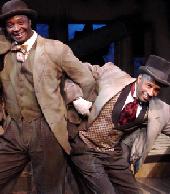SITE GUIDE
SEARCH
REVIEWS
REVIEW ARCHIVES
ADVERTISING AT CURTAINUP
FEATURES
NEWS
Etcetera and
Short Term Listings
LISTINGS
Broadway
Off-Broadway
NYC Restaurants
BOOKS and CDs
OTHER PLACES
Berkshires
London
California
New Jersey
DC
Philadelphia
Elsewhere
QUOTES
On TKTS
PLAYWRIGHTS' ALBUMS
LETTERS TO EDITOR
FILM
LINKS
MISCELLANEOUS
Free Updates
Masthead
Writing for Us
A CurtainUp New Jersey Review
Minstrel Show, Or the Lynching of William Brown

l-r: Kelcey Watson and Spencer Scott Barros
|
Although it is about an infamously real lynching on the street in front of the Douglas County Courthouse in Omaha, Nebraska in 1919, Max Sparber's play echoes with a social imperative as close as yesterday. What could make this documented incident that took place in front of 5,000 enraged and vengeful townspeople 87 years ago seem so frighteningly relevant?
The shameful memory of a lynch mob and the horrifying image of a noose came back to haunt us recently when a group of white teenagers went unpunished for hanging nooses on a tree on the grounds of their high school in Jena, Louisiana. They did this in response to a black student who chose to sit under the tree presumably designated for white students only. Although the white students were not punished for this hate crime, the subsequent attack, in retaliation, by a group of black students on one white student brought severe charges including one for attempted murder.
The incident has since been resolved in court as a result of committed and peaceful demonstrations and a nationwide outcry that the laws of justice must serve the different races equally. That we have to be reminded of a miscarriage of justice is Minstrel Show's most salient and pertinent aspect. The idea that racism and bigotry remain deeply embedded in our culture is reflected in this play in which two black-faced black men are making a living touring the country in a minstrel show depicting (as they call it) a "Tableau of Negro Life." Fate finds them in jail with William Brown, who has been charged with molesting a white girl. Call it story-theater, theater of testimony, or a dramatic narrative, the play revisits the lynching through the eyewitness testimony of one of the minstrel performers, although both are unwittingly drawn into the eye of a racist storm.
Despite a length of just 85 minutes, the play takes too long to engage our interest in the two men even as their back story as itinerant minstrels is a curious one. The first part finds the two men performing part of their repertory— some rather lame humorless skits and tame songs. The play's conceit undoubtedly is to have the minstrels solicit our empathy and arouse our sense of guilt. That they are not meaning to be entertaining takes a little getting used to. The problem, however, is that there is a very long stretch of meandering talk before the men get to the heart of the matter, how they were brutalized, jailed and victimized with one becoming an unwitting key witness to mob rule.
Under Rob Urbinati's direction, the action and the interplay between the men is so tentative that the experience is like watching a rehearsal. That too may be part of the author's device, but it's unclear.
The play's dramatic arc and the actor's motives become clearer as their concerted narrative becomes more directly focused on the lynching. The performances by Barros and Watson are perfectly fine as their mission to testify to this shameful chapter in American history becomes the play's raison d'etre. It is a pity that the stirring climactic moments are preceded by so much protracted and labored exposition.
LINK
Review of 1999 production of Minstrel Show
|
Minstrel Show, Or the Lynching of William Brown By Max Sparber Directed by Rob Urbinati Scenic Design: Quinn K. Stone Lighting Design: Jill Nagle Costume Design: Patricia E. Doherty Sound Design: Jessica Paz New Jersey Repertory Company, at the Lumia Theater, 179. Broadway, Long Branch, NJ 07740 – (732) – 229 – 3166 Tickets: ($35) Running Time: 1 hour 25 minutes (no intermission) Performances Thursday and Fridays at 8 PM; Saturdays at 3 PM and 8 PM and Sundays at 2 and 7 PM. Previews began 09/27/07; Opened 09/29/07; Ends 10/28/07 Review by Simon Saltzman based on performance September 29, 2007 |
Try onlineseats.com for great seats to
Wicked
Jersey Boys
The Little Mermaid
Lion King
Shrek The Musical

The Playbill Broadway YearBook

Leonard Maltin's 2007 Movie Guide
Leonard Maltin's 2005 Movie Guide

 >
>

Wicked
Jersey Boys
The Little Mermaid
Lion King
Shrek The Musical

The Playbill Broadway YearBook

Leonard Maltin's 2007 Movie Guide
Leonard Maltin's 2005 Movie Guide

 >
>

